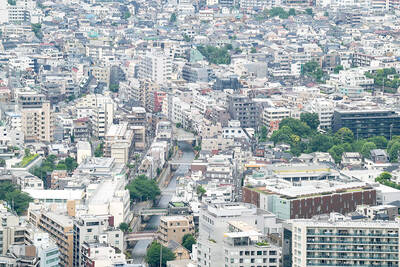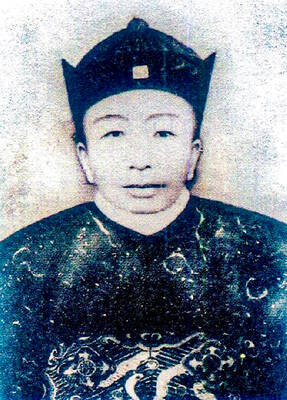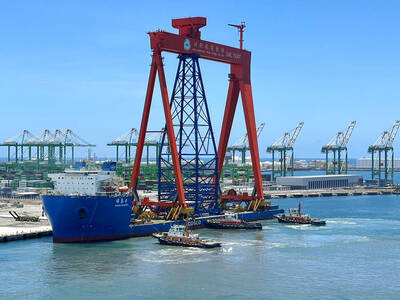Cheers erupted from the packed crowd at Ravenel’s autumn auction over the weekend when bids on Zao Wou-ki’s (趙無極) painting 17.4.64 surpassed the NT$100 million mark — outstripping by far its pre-sale estimate of NT$62 million.
And the bidding wasn’t even close to slowing down. The 1964 copper-colored abstract painting, infused with yellow and brown tones surrounded by furious dark brush strokes, was the most prominent item up for bids in the auction’s 227 lots.
Heads craned to the back of the seating area as one non-descript buyer competed with a phone-in bidder. Applause thundered throughout the cavernous room in the bowels of Fubon Life Building when the gavel hit the block at NT$140 million (not including sale charges), breaking Taiwan’s previous auction record for modern art.
After the excitement of the roughly five-minute volley, Clara Kuo (郭倩如), Ravenel’s general manager and principle auctioneer, lost her bearings and forgot to ask the buyer’s bid number after the hammer fell. She quickly recovered and the auction continued amid guffaws from the audience.
Kuo’s brisk, though somewhat bland, auctioneering style (her constant references to paintings as “cute” or “beautiful” revealed little of her expertise in modern and contemporary art), kept bidders on the edge of their seats.
Works by established Asian masters flew off the auction block at what was said to be Ravenel’s largest auction in its 10-year history, though works by younger artists sold at a less impressive rate. Regardless, when the gavel fell for the last time at around 8:30pm on Sunday, Ravenel had sold 85 percent of its 192 lots for just over NT$668 million (US$20.7 million) [see correction below].
As with Christie’s Hong Kong auction the previous week, Zao’s paintings were among the favorites. His Birds Fly Everywhere (1952) sold for NT$63.2 million, while Small Bridge Over the Stream (1955) took NT$15.6 million — both exceeding by a third their pre-sale high estimates.
Another prominent item at the auction was Vase of Flower With Blue Ground (1956), a smallish-sized painting of snow-white and peacock-blue flowers in a vase on a background of ultramarine by Chinese artist Sanyu (常玉).
There was a brief lull when bidding for the work reached NT$40 million. Sensing there were a few more bids out there, Kuo had the painting paraded to the back of the room. It worked. The painting eventually fetched NT$59.8 million.
More remarkable was the fact that a simple charcoal-and-ink nude sketched on paper by the same artist sold for NT$300,000.
Chu Teh-chun (朱德群) received somewhat mixed bids for his works. The four-panel Force d’Ame by the France-based Chinese artist sold for NT$38 million, lower than the NT$42 million high estimate, though significantly above the NT$20 million starting bid. Chu’s Composition No. 166, however, raked in NT$16.8 million. Its pre-sale high estimate was NT$10 million.
Works by modern artists created after 1990 generally underperformed.
Two pieces by contemporary Taiwanese painter Lu Hsien-ming (陸先銘) sold below their lowest pre-sale estimates, and Lien Chien-hsing’s (連建興) Water’s Edge (淨心池畔Ⅱ) just barely exceeded its lowest pre-sale estimate. Some post-1990 works didn’t sell at all, with the overwhelming majority of the auction’s 35 unsold items coming from this period.
The kitschy 2005 sculpture Contemporary Terracotta Warriors — Series No. 6 (現代兵馬俑系列之六) by Chinese artist Yue Minjun (岳敏君), which depicts the artist’s goofily smiling head on a body resembling one of Qin Shi Huang’s (秦始皇) iconic terra-cotta warriors, had a pre-sale estimate of between NT$4 million and NT$5 million. It received no bids. Nor did Yang Shaobin’s (楊少斌) 2006 work Shadow (陰影), which had a pre-sale estimate of between NT$1.1 million and NT$1.8 million.
Correction: On Sunday, Ravenel had sold 85 percent of its auction catalog, or 192 lots, not 85 percent of its 192 lots as stated in the article. The Taipei Times regrets the error.

The canonical shot of an East Asian city is a night skyline studded with towering apartment and office buildings, bright with neon and plastic signage, a landscape of energy and modernity. Another classic image is the same city seen from above, in which identical apartment towers march across the city, spilling out over nearby geography, like stylized soldiers colonizing new territory in a board game. Densely populated dynamic conurbations of money, technological innovation and convenience, it is hard to see the cities of East Asia as what they truly are: necropolises. Why is this? The East Asian development model, with

June 16 to June 22 The following flyer appeared on the streets of Hsinchu on June 12, 1895: “Taipei has already fallen to the Japanese barbarians, who have brought great misery to our land and people. We heard that the Japanese occupiers will tax our gardens, our houses, our bodies, and even our chickens, dogs, cows and pigs. They wear their hair wild, carve their teeth, tattoo their foreheads, wear strange clothes and speak a strange language. How can we be ruled by such people?” Posted by civilian militia leader Wu Tang-hsing (吳湯興), it was a call to arms to retake

This is a deeply unsettling period in Taiwan. Uncertainties are everywhere while everyone waits for a small army of other shoes to drop on nearly every front. During challenging times, interesting political changes can happen, yet all three major political parties are beset with scandals, strife and self-inflicted wounds. As the ruling party, the Democratic Progressive Party (DPP) is held accountable for not only the challenges to the party, but also the nation. Taiwan is geopolitically and economically under threat. Domestically, the administration is under siege by the opposition-controlled legislature and growing discontent with what opponents characterize as arrogant, autocratic

When Lisa, 20, laces into her ultra-high heels for her shift at a strip club in Ukraine’s Kharkiv, she knows that aside from dancing, she will have to comfort traumatized soldiers. Since Russia’s 2022 invasion, exhausted troops are the main clientele of the Flash Dancers club in the center of the northeastern city, just 20 kilometers from Russian forces. For some customers, it provides an “escape” from the war, said Valerya Zavatska — a 25-year-old law graduate who runs the club with her mother, an ex-dancer. But many are not there just for the show. They “want to talk about what hurts,” she